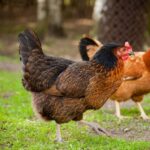Pheasants can live with chickens, yes. There are some general rules to follow to ensure both your chickens and pheasants are safe. Both species need their space and each has some specific conditions, but it’s really not difficult at all.
Table of Contents
Do Chickens and Pheasants Get Along?
Generally speaking, chickens and pheasants will get along just fine. Both chickens and pheasants are fairly docile birds and as long as integrating them is properly managed, they will not fight often, if at all.
There are a few circumstances where issues can arise, these are:
Male Pheasants and Roosters
It’s almost always the males that cause the problems. Both male pheasants and male chickens (roosters) are much more prone to aggressive behavior than females.
This will usually be over territory, mates, or just because they want to assert dominance. If you have males, it’s a good idea to ensure they have plenty of their own space.
Don’t be deceived by pheasants’ smaller build, they have spurs like roosters do and will use them if they feel the need to.
Keep an eye on them for any signs of aggression when they’re sharing space and separate them at the earliest sign of aggression.
Cramped Conditions
Overcrowding is one of the leading causes of pecking and fighting amongst chickens - and birds in general - yet it’s something that is entirely in our control.
Don’t pack too many birds into the same space! I know how addictive it is raising backyard birds, but we always have to put their welfare first.
Much like chickens, pheasants need some company from their own species. 2-3 birds are a minimum, from there it’s really a case of providing a good few feet per bird at a minimum.
There shouldn’t be any issues allowing chickens and pheasants to mingle, as long as they have open space when doing so.
When enclosed, pheasants are typically kept in a large aviary and/or a run. Generally speaking, they require more space than chickens.
If you have the space to let both pheasants and chickens roam free, you need to be aware that pheasants do not tend to stay as a flock as chickens do.
They will roam further away from their home, and they will venture off alone most of the time.
Food Sources
Pheasants and chickens have different dietary requirements. Pheasants need a higher protein diet, so it’s a good idea to keep their feeders somewhere they can’t dip into.
Plus it’s a good idea to keep their feed separate to prevent fighting. Both species can get territorial over food, and who can blame them?
When it comes to foraging for bugs, that’s all fair game of course. You’ll notice pheasants tend to go further afield and find their own treats that your chickens probably wouldn’t have found anyway.
Related - Here's what you need to know about raising peafowl with chickens.
Do Pheasants Attack Chickens?
I’ve spoken with a few poultry owners that have raised both pheasants and chickens together and they told me that any incidents of aggression were very rare.
You should be aware that male pheasants do have sharp spurs and will use them to fight other pheasants just as roosters do though.
They’re capable of doing some serious damage, too. They just aren’t that aggressive when they have the space and freedom to roam around, and food and shelter on your land.

Do Pheasants Need a Coop?
Pheasants do not need a coop, no. They should not share a coop with chickens either, that’s too big of a risk that they will fight when you’re not around to break them up.
They’re typically kept in large aviaries or pens. Pheasants are more vulnerable to predators than chickens, so a lot of owners keep them in their pens most of the time if they let them out at all.
The Potential for Diseases
Pheasants are game birds and as such present a (slight) risk of infecting chickens with diseases that are more commonly found affecting game birds.
The most common disease found among game birds is called Blackhead disease. This is a parasite that is typically spread via roundworms.
Once it gets into a bird’s digestive system it causes considerable damage to the cecum and other parts of the digestive tract and liver.
In addition to this, both species have a lot of bacteria in their poop. To minimize the risk of cross-contamination, always practice good biosecurity when entering each coop/enclosure.
Keep a spare pair of shoes outside the entrance to your chicken’s coop/run and your pheasant’s enclosure. This way you can quickly swap shoes before entering and not trek poop in and out of each area.
Related - How to safely raise turkeys with chickens.
How Do You Tell the Difference Between a Male and Female Pheasant?
If you have pheasants and aren’t sure if they’re male or female, it’s very easy to tell the difference.
Males are much more colorful. The common varieties have green heads with a red ‘helmet’ leading into their wattles, black tails, and small crests.
Although, they do range in colors from almost completely white to completely black when talking about the rarer breeds.
Females on the other hand are a lot blander. Much like some ducks, like mallards, it’s the males that have all the colors and the females are a mottled brown.
In Summary
With enough space and the males kept in check, pheasants and chickens can live together just fine.
In fact, you’ll have loads of fun watching them interact with each other.
Just keep in mind that pheasants are very different from chickens. They require different nutrition, are much more prone to flying further afield, and you need to be mindful of biosecurity.
Resources
Image credits - Header photo by Ben Seymour, in-body photo by Anne Benson on Unsplash




